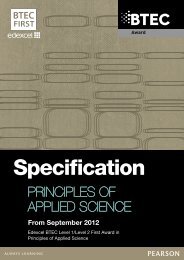BTEC First Award in Application of Science - specification - Edexcel
BTEC First Award in Application of Science - specification - Edexcel
BTEC First Award in Application of Science - specification - Edexcel
Create successful ePaper yourself
Turn your PDF publications into a flip-book with our unique Google optimized e-Paper software.
UNIT 5: APPLICATIONS OF CHEMICAL SUBSTANCES<br />
Suggested assignment outl<strong>in</strong>es<br />
The table below shows a programme <strong>of</strong> suggested assignment outl<strong>in</strong>es that cover the assessment criteria. This is guidance and it is<br />
recommended that centres either write their own assignments or adapt any assignments we provide to meet local needs and resources.<br />
Criteria covered Assignment Scenario Assessment evidence<br />
1A.1, 2A.P1, 2A.M1,<br />
2A.D1<br />
Hot or Cold? You are a technical science representative for a<br />
company that makes heat packs and cold packs<br />
to treat m<strong>in</strong>or <strong>in</strong>juries. You must expla<strong>in</strong> to your<br />
customers how the products work.<br />
Experimental reports, <strong>in</strong>clud<strong>in</strong>g<br />
diagrams and graphs.<br />
A visit<strong>in</strong>g speaker from <strong>in</strong>dustry could be asked<br />
to give a talk on exothermic and endothermic<br />
reactions.<br />
1B.2, 2B.P2, 2B.M2,<br />
2B.D2<br />
The Importance <strong>of</strong><br />
the Fractions <strong>of</strong><br />
Crude Oil<br />
You work as an environmental scientist for the<br />
government. You have been asked to research<br />
how the crude oil used <strong>in</strong> Brita<strong>in</strong> is currently<br />
ref<strong>in</strong>ed and used at present.<br />
A written report with diagrams.<br />
A visit<strong>in</strong>g speaker could be <strong>in</strong>vited <strong>in</strong> or a visit to<br />
a ref<strong>in</strong>ery would help put this <strong>in</strong>to context.<br />
1B.3, 1B.4, 2B.P3,<br />
2B.P4, 2B.M3,<br />
2B.M4, 2B.D3<br />
How Can We<br />
Identify Organic<br />
Chemicals?<br />
You work as an analytical chemist for a waste<br />
treatment company that blends used organic<br />
compounds for use <strong>in</strong> cement kilns.<br />
You have received several drums <strong>of</strong> organic<br />
waste from a company. You need to confirm<br />
what is <strong>in</strong> the drums <strong>in</strong> order to treat the waste<br />
correctly and present your f<strong>in</strong>d<strong>in</strong>gs to your<br />
manager.<br />
Presentation on the structure, uses and<br />
environmental impact <strong>of</strong> a range <strong>of</strong><br />
organic chemicals, to <strong>in</strong>clude a practical<br />
report, models and diagrams.<br />
A visit<strong>in</strong>g analytical chemist or visit to a waste<br />
company would help put this <strong>in</strong>to context.<br />
48<br />
BF029957 – Specification – <strong>Edexcel</strong> <strong>BTEC</strong> Level 1/Level 2 <strong>First</strong> <strong>Award</strong> <strong>in</strong> <strong>Application</strong> <strong>of</strong> <strong>Science</strong> –<br />
Issue 1 – March 2012 © Pearson Education Limited 2012








